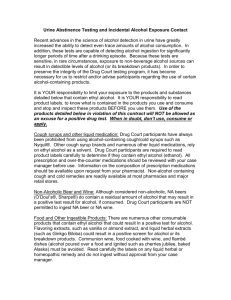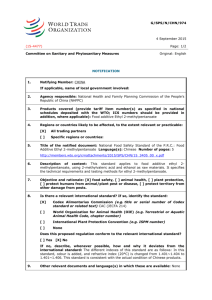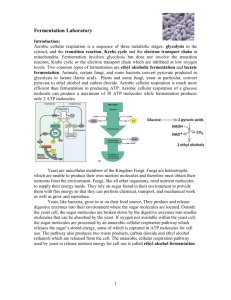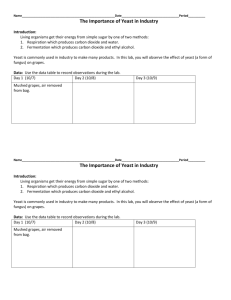Influence of Media Composition and Temperature on Volatile Aroma
advertisement
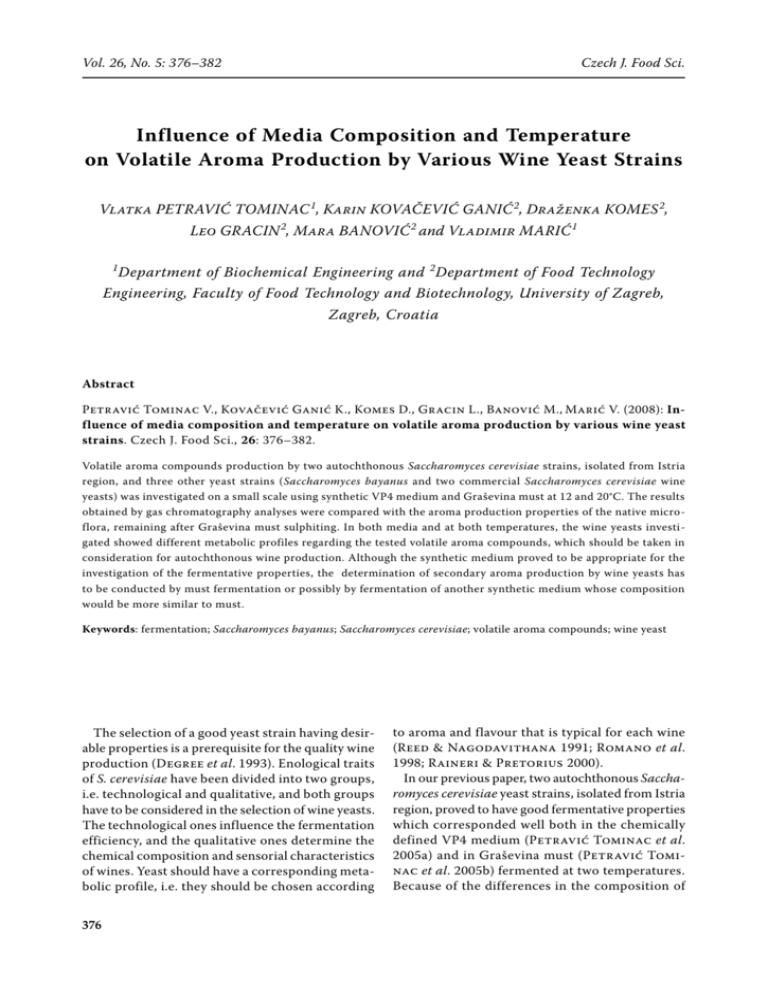
Vol. 26, No. 5: 376–382 Czech J. Food Sci. Influence of Media Composition and Temperature on Volatile Aroma Production by Various Wine Yeast Strains Vlatka Petravić Tominac 1, Karin Kovačević Ganić 2, Draženka Komes 2, Leo Gracin 2, Mara Banović 2 and Vladimir Marić 1 1 Department of Biochemical Engineering and 2Department of Food Technology Engineering, Faculty of Food Technology and Biotechnology, University of Zagreb, Zagreb, Croatia Abstract Petravić Tominac V., Kovačević Ganić K., Komes D., Gracin L., Banović M., Marić V. (2008): Influence of media composition and temperature on volatile aroma production by various wine yeast strains. Czech J. Food Sci., 26: 376–382. Volatile aroma compounds production by two autochthonous Saccharomyces cerevisiae strains, isolated from Istria region, and three other yeast strains (Saccharomyces bayanus and two commercial Saccharomyces cerevisiae wine yeasts) was investigated on a small scale using synthetic VP4 medium and Graševina must at 12 and 20°C. The results obtained by gas chromatography analyses were compared with the aroma production properties of the native microflora, remaining after Graševina must sulphiting. In both media and at both temperatures, the wine yeasts investigated showed different metabolic profiles regarding the tested volatile aroma compounds, which should be taken in consideration for autochthonous wine production. Although the synthetic medium proved to be appropriate for the investigation of the fermentative properties, the determination of secondary aroma production by wine yeasts has to be conducted by must fermentation or possibly by fermentation of another synthetic medium whose composition would be more similar to must. Keywords: fermentation; Saccharomyces bayanus; Saccharomyces cerevisiae; volatile aroma compounds; wine yeast The selection of a good yeast strain having desirable properties is a prerequisite for the quality wine production (Degree et al. 1993). Enological traits of S. cerevisiae have been divided into two groups, i.e. technological and qualitative, and both groups have to be considered in the selection of wine yeasts. The technological ones influence the fermentation efficiency, and the qualitative ones determine the chemical composition and sensorial characteristics of wines. Yeast should have a corresponding metabolic profile, i.e. they should be chosen according 376 to aroma and flavour that is typical for each wine (Reed & Nagodavithana 1991; Romano et al. 1998; Raineri & Pretorius 2000). In our previous paper, two autochthonous Saccharomyces cerevisiae yeast strains, isolated from Istria region, proved to have good fermentative properties which corresponded well both in the chemically defined VP4 medium (Petravić Tominac et al. 2005a) and in Graševina must (Petravić Tominac et al. 2005b) fermented at two temperatures. Because of the differences in the composition of Czech J. Food Sci. Vol. 26, No. 5: 376–382 the two fermentation media, the aim of this work was to evaluate the metabolic profiles of the yeast strains in both media using a new gas chromatographic method developed in our laboratory. MATERIAL AND METHODS Microorganisms. Two Saccharomyces cerevisiae yeast strains (Zim 1899 and ZIM 1900) were isolated from Istria region in our previous work (Petravić Tominac et al. 2005a). Strain Z-2 (Saccharomyces bayanus) and two commercial wine yeast strains (both Saccharomyces cerevisiae), denominated as A and B, were used to compare the wine yeast strains properties. Yeast strains were previously identified by sequencing D1/D2 region of the 26 S rDNA, as described in “Yeast of the world. Morphology, physiology, sequences and identification, Version 2.0” (software) (Boeckout et al. 2002). The native microflora, remaining after Graševina must sulphiting, was used as well for spontaneous fermentation. Media. Synthetic VP4 medium was used for inocula cultivation and microfermentation. The composition of VP4 medium, containing yeast extract and peptone, is partially in agreement with the must composition as concerns sugar and nitrogen contents, pH value and the buffer capacity (Petravić Tominac et al. 2005a). Graševina must from Križevci area, Croatia, was used for microvinification (Petravić Tominac et al. 2005b). Fermentation. The fermentation inocula preparation, as well as microfermentation of VP4 medium and microvinifications at 12 and 20°C, were done in triplicates as published previously (Petravić Tominac et al. 2005a, b). Yeast inocula used in both experiments was of 2 × 10 6 cells/ml. The fermented synthetic media and the produced wines were centrifuged and the supernatants were frozen for later analysis. Headspace gas chromatography (HSS-GC). The concentrations of nine volatile aroma compounds (acetaldehyde, diacetyl, isoamyl alcohol, ethyl acetate, isoamyl acetate, ethyl propionate, ethyl hexanoate, ethyl octanoate, and ethyl lactate) were determined by gas chromatography using a Varian 3300 gas chromatograph with a split/splitless injector and a flame ionisation detector (FID). For the headspace analyses, Hewlett Packard headspace sampler HP 7694 was used. The method developed in our laboratory involved the injection of the standard and the analysed compounds, the determination of their retention times, and optimisation of carrier gas flow and working temperatures. The compounds of interest were resolved on a DB-624 capillary column (30 m × 0.25 mm i.d.× df = 0.25 μm) with the following parameters: the initial oven temperature of 35°C was kept for 2 min, then it was raised by 10°C/min to 90°C followed by 15°C /min to 150°C and kept for 7 min at 150°C. The injection port temperature was kept at 120°C, the carrier gas (nitrogen) pressure flow was 3 ml/min. The detector temperature was 200°C. The headspace sampler was equipped with a standard 1 ml loop. The carrier gas pressure was 4.4 Psi, vial pressure 7 Psi and injection time 0.2 min. The samples were equilibrated by heating at 80°C for10 minutes. Qualitative analysis was carried out by comparison of the retention times of the standards and the corresponding peaks obtained with the samples. The quantification was carried out by comparison of the areas of the peaks to those of the internal standard. Statistical analysis. Statistical analyses of the experimental data were done by ANOVA using Excel 2000 (Anonymous 2002) and Duncan’s multiple range test (Montgomery 1984). RESULTS AND DISCUSSION The basic fermentative properties of the tested yeast strains in VP4 medium and Graševina must fermented at two temperatures were published in our previous papers (Petravić Tominac et al. 2005a, b). Alcohol contents obtained in the final products and fermentation times are shown in Table 1. Alcohol contents and fermentation times for the fermentations performed in VP4 medium (Petravić Tominac et al. 2005a) and in Graševina must (Petravić Tominac et al. 2005b) Fermentation temperature (°C) Fermented VP4 medium Graševina must φ(ethanol) (%) t (days) φ(ethanol) (%) t (days) 12 9.25–9.88 59 11.41–12.05 29 20 8-79–9.22 38 11.21–11.81 21 377 Vol. 26, No. 5: 376–382 Czech J. Food Sci. Table 2. Concentrations of volatile aroma compounds (mg/l) in sterile synthetic VP4 medium and sulphited Graševina must Volatile compound γ (mg/l) Fermentation medium VP4 medium Graševina must Acetaldehyde 1.08 9.00 Diacetyl 0 0.62 Ethyl acetate 4.57 0.20 Ethyl propionate 0 0 Isoamyl alcohol 1.68 1.65 Ethyl hexanoate 0.44 0 13.45 0 Ethyl octanoate 0.57 0 Isoamyl acetate 1.12 0.01 Ethyl lactate Table 1. The aim of this work was to compare the production of volatile aroma compounds by the wine yeasts investigated in synthetic medium and in must fermented at two temperatures. The most pronounced differences between the sterilised unfermented VP4 medium and sulphited Graševina must regarding the volatile compounds were found with ethyl octanoate, following by acetaldehyde and ethyl acetate (Table 2). The levels of the volatile aroma compounds determined in fermented VP4 medium are shown in Table 3 shows the concentrations of the same compounds in produced wines. Lower fermentation temperature The concentrations of the analysed volatile aroma compounds in synthetic VP4 medium and in must fermented at 12°C are shown in Tables 3 and 4, respectively. Diacetyl concentrations present in all samples of both fermented media were higher than the usual literature values for wine, possibly because the samples were taken immediately after the end of fermentation, without maturation during which these concentrations would have been lowered (Bartowsky & Henschke 2004). The levels of diacetyl produced in must fermentation using different yeast strains were approximately 3 times higher than its levels in synthetic VP4 medium. The only exceptions were fermentations performed by commercial yeast starters A and B. 378 Although the increased diacetyl concentrations in wine can be produced by lactic acid bacteria that are able to produce much higher diacetyl levels than yeasts (Lambrechts & Pretorius 2000), in our work this was not the probable reason. Lactic acid bacteria could be still present in sulphited must, but the presence of bound SO 2 of 50–100 mg/l or free SO 2 of 1–10 mg/l is sufficient to inhibit their growth in wine (Romano & Suzzi 1993). Since the must was initially sulphited with 100 mg/l of SO2 and at the moment of inoculation it contained 74.88 mg/l of total SO2 (10.24 mg/l of free SO2 and 64.64 mg/l of bound SO 2) (Petravić Tominac et al. 2005b), the growth of lactic acid bacteria was considered to be repressed and their number was not determined in this work. The more probable reason for the increased diacetyl levels was that yeast physiological activity was negatively affected by sulphite added into must, which could favour diacetyl formation, similar to the well documented brewing of beer wort (Bartowsky & Henschke 2004). This presumption could be confirmed as well by diacetyl levels formed in spontaneously fermented wine (Table 4). Acetaldehyde levels in both media and at both temperatures (Tables 3 and 4) were in agreement with the data of Romano et al. (1998), who reported that almost 90% of Saccharomyces cerevisiae wine strains produced less than 50 mg/l acetaldehyde. Among the investigated yeasts, ZIM 1899 and commercial yeast B produced the lowest but about equal acetaldehyde concentrations in synthetic VP4 medium (Table 3). Most of the investigated yeasts produced higher acetaldehyde concentrations in must than in synthetic medium fermentation. Apart from the differences in the fermentation media composition, it could be also due to sulphite added to must. It is known that acetaldehyde combines with sulphur dioxide in wines made from healthy grapes and acetaldehyde production can be a yeast self-defence mechanism. The formation of acetaldehyde is known as a strain-dependent property. Acetaldehyde values determined in our work referred to free acetaldehyde, not to its fraction bound to sulphite. The levels of isoamyl alcohol were similar in both fermented media but about 30–50% higher in wines, depending on the yeast strain. Generally, ethyl acetate formation was higher during must fermentation than during fermentation of the synthetic medium, because ethanol and acetic acid are most abundant in wine. Commercial Czech J. Food Sci. Vol. 26, No. 5: 376–382 Table 3. Concentrations of volatile aroma compounds (mg/l) in synthetic VP4 medium fermented at 12°C and 20°C Volatile compound γ (mg/l) Inoculated yeast strain ZIM 1900 ZIM 1899 Z-2 A B 42.26 ± 7.721 16.50 ± 3.106 45.80 ± 12.848 23.47 ± 18.678 10.60 ± 5.792 6.42 ± 0.972 6.09 ± 1.259 6.84 ± 2.249 5.95 ± 0.245 6.35 ± 2.546 30.12 ± 2.698 35.40 ± 6.556 30.47 ± 8.892 47.35 ± 3.562 37.06 ± 15.756 Ethyl propionate 0.12 ± 0.003 0.08 ± 0.022 0.17 ± 0.059 0.07 ± 0.050 0.04 ± 0.021 Isoamyl alcohol 53.68 ± 4.548 57.42 ± 10.135 51.87 ± 15.183 74.00 ± 3.644 50.90 ± 20.763 Ethyl hexanoate 0.44 ± 0.086 0.26 ± 0.080 0.39 ± 0.158 0.24 ± 0.020 0.23 ± 0.180 13.45 ± 3.667 10.85 ± 2.940 13.95 ± 2.872 11.72 ± 1.104 11.15 ± 0.873 Ethyl octanoate 0.57 ± 0.086 0.30 ± 0.135 0.57 ± 0.286 0.30 ± 0.068 0.32 ± 0.319 Isoamyl acetate 1.12 ± 0.115 0.89 ± 0.405 0.76 ± 0.313 1.88 ± 0.323 0.89 ± 0.849 Acetaldehyde 9.61 ± 1.751 6.80 ± 0.977 13.55 ± 0.248 8.96 ± 0.301 10.01 ± 5.849 Diacetyl 7.54 ± 1.438 6.10 ± 0.294 9.105 ± 1.500 8.27 ± 0.063 11.23 ± 2.017 45.37 ± 5.837 40.83 ± 3.845 44.41 ± 7.357 58.03 ± 0.704 108.12 ± 22.961 Ethyl propionate 0.04 ± 0.008 0.04 ± 0.003 0.06 ± 0.004 Isoamyl alcohol 57.02 ± 7.246 48.33 ± 3.169 59.37 ± 9.479 65.23 ± 0.391 103.12 ± 23.292 Ethyl hexanoate 0.41 ± 0.129 0.19 ± 0.045 0.46 ± 0.076 0.31 ± 0.013 0.32 ± 0.047 14.13 ± 1.010 11.52 ± 1.489 13.30 ± 0.630 12.28 ± 1.204 11.60 ± 4.797 Ethyl octanoate 0.41 ± 0.163 0.23 ± 0.037 0.49 ± 0.089 0.45 ± 0.073 0.47 ± 0.174 Isoamyl acetate 0.75 ± 0.172 0.49 ± 0.063 0.72 ± 0.036 1.31 ± 0.021 0.97 ± 0.145 Fermented at 12°C Acetaldehyde Diacetyl Ethyl acetate Ethyl lactate Fermented at 20°C Ethyl acetate Ethyl lactate yeast strain A was an exception, producing less ethyl acetate in must fermentation. For most strains and at both temperatures, the concentrations of ethyl hexanoate and ethyl octanoate were lower in the fermented (Table 3) than in the non-fermented synthetic VP4 medium (Table 2). It could be concluded that the activity of ethyl hexanoate-synthesising enzyme, ethanol hexanoyl transferase Eht 1p, was lower in VP4 medium than was the activity of ethyl hexanoatehydrolysing enzymes (Verstrepen et al. 2003). Similarly, if there was any ethyl octanoate-synthesising activity in VP4 medium, it was in most cases lower than its hydrolysing activity (Lambrechts & Pretorius 2000). The concentrations of ethyl lactate produced by all yeast strains were similar, but slightly higher in wines (Table 4). Ethyl lactate levels formed in spontaneous fermentations were not significantly different from those obtained with inoculated 0.03 ± 0.0059 0.04 ± 0.012 fermentations. Differences also occurred between ethyl propionate levels in wine and VP4 medium. Spontaneous must fermentation gave less ethyl hexanoate than inoculated fermentations. Although ethyl hexanoate, ethyl octanoate, and ethyl lactate were present in non-fermented synthetic medium and absent from Graševina must (Table 2), their concentrations were higher in wines (Table 4) than in VP4 fermented medium (Table 3), supposedly because the enzyme activity responsible for their synthesis was higher in must than in VP4 medium (Verstrepen et al. 2003). Fermentation at higher temperature Generally, higher concentrations of diacetyl in both media were produced at 20°C (Tables 3 and 4). On the contrary, acetaldehyde levels produced at 20°C were smaller than its levels at 12°C but much higher in wine than in the fermented synthetic 379 380 3.06 ± 0.470 Isoamyl acetate 0.65 ± 0.076 Ethyl hexanoate 0.90 ± 0.249 3.44 ± 0.501 Ethyl octanoate Isoamyl acetate 16.59 ± 2.399 123.55 ± 16.043 Isoamyl alcohol Ethyl lactate 0.08 ± 0.012 Ethyl propionate 112.04 ± 13.935 15.77 ± 2.856 Diacetyl Ethyl acetate 40.39 ± 5.833 Acetaldehyde Fermented at 20°C 1.05 ± 0.378 Ethyl octanoate 15.61 ± 1.877 0.68 ± 0.151 Ethyl hexanoate Ethyl lactate 73.93 ± 10.727 Isoamyl alcohol 47.12 ± 6.381 Ethyl acetate 0.09 ± 0.029 17.98 ± 3.332 Diacetyl Ethyl propionate 43.63 ± 7.939 ZIM 1900 Acetaldehyde Fermented at 12°C Volatile compound γ (mg/l) 3.44 ± 0.501 0.90 ± 0.249 16.59 ± 2.399 0.65 ± 0.076 123.55 ± 16.043 0.08 ± 0.012 112.04 ± 13.935 15.77 ± 2.856 40.39 ± 5.833 2.60 ± 0.856 0.98 ± 0.475 15.64 ± 0.915 0.65 ± 0.254 68.27 ± 18.921 0.086 ± 0.0336 44.78 ± 13.044 16.16 ± 4.0315 41.07 ± 10.606 ZIM 1899 2.77 ± 0.746 0.80 ± 0.279 15.84 ± 2.176 0.56 ± 0.161 100.04 ± 19.606 0.07 ± 0.018 83.62 ± 16.219 13.76 ± 2.870 34.59 ± 7.410 3.48 ± 0.575 1.33 ± 0.248 16.26 ± 2.358 0.89 ± 0.115 92.67 ± 4.230 0.12 ± 0.029 61.36 ± 2.957 22.99 ± 1.542 62.11 ±12.965 Z-2 Inoculated yeast strain 2.76 ± 0.537 0.75 ± 0.209 15.59 ± 1.073 0.49 ± 0.081 92.45 ± 24.884 0.06 ± 0.017 80.47 ± 20.569 10.74 ± 2.375 27.84 ± 4.967 2.49 ± 0.853 0.83 ± 0.218 15.71 ± 0.833 0.53 ± 0.165 59.77 ± 23.250 0.07 ± 0.031 39.19 ± 14.888 8.30 ± 5.677 34.56 ± 12.139 A Table 4. Concentrations of volatile aroma compounds (mg/l) ) in Graševina wine produced at 12°C and 20°C 2.95 ± 0.569 0.93 ± 0.080 17.03 ± 2.216 0.55 ± 0.086 117.54 ± 31.248 0.07 ± 0.032 109.06 ± 22.734 14.26 ± 2.945 35.94 ± 3.959 2.53 ± 1.484 0.87 ± 0.644 13.90 ± 2.728 0.58 ± 0.377 64.69 ± 31.831 0.08 ± 0.042 42.90 ± 21.092 13.82 ± 6.283 35.45 ± 15.738 B 2.15 ± 0.451 0.19 ± 0.048 16.30 ± 1.663 0.27 ± 0.067 96.56 ± 18.653 0.06 ± 0.011 88.20 ± 16.037 12.01 ± 2.113 30.05 ± 3.284 1.92 ± 0.410 0.94 ± 0.208 16.04 ± 1.150 0.46 ± 0.083 66.50 ± 13.760 0.10 ± 0.033 46.11 ± 9.399 15.65 ± 3.717 40.90 ± 20.195 Spontaneous fermentation Vol. 26, No. 5: 376–382 Czech J. Food Sci. Czech J. Food Sci. Vol. 26, No. 5: 376–382 medium. Partial reason for this was a significantly higher concentration of this compound in sulphited must than in the non-fermented synthetic medium (Table 2). Wines produced at 20°C contained higher concentrations of isoamyl alcohol (Table 4). Its concentration was almost 2 times higher than in VP4 medium fermented under the same conditions (Table 3). Most of the yeasts starters used for microvinification resulted in higher levels of isoamyl alcohol in comparison to those that were produced in spontaneous fermentations. Higher ethyl acetate levels were produced at the higher temperature in both media (Tables 3 and 4), which is in agreement with the literature (Verstrepen et al. 2003). Generally, VP4 medium fermented at the higher temperature contained higher amounts of isoamyl acetate (Table 3). Its concentrations in the wine samples were significantly higher than in the fermented VP4 medium (Table 4). Spontaneous must fermentation gave considerably less isoamyl acetate than inoculated fermentations. The concentrations of ethyl lactate in wine were similar to those produced at 12°C. The difference caused by different temperatures was most pronounced with commercial yeast strain B. Ethyl lactate levels formed in spontaneous fermentations were not significantly different from those obtained after inoculated fermentations. In both media, ethyl propionate concentrations were mostly smaller than that at 12°C. Differences also occurred between ethyl propionate levels in wine and those in VP4 medium. Decreased levels of ethyl hexanoate and ethyl octanoate were observed in VP4 medium at 20°C, as well as at the lower temperature. Spontaneous must fermentation gave less ethyl hexanoate than inoculated fermentations, as found at 12°C, as well. Regarding ethyl hexanoate, ethyl octanoate, and ethyl lactate, their concentrations were higher in wines as already noticed at 12°C. Only acetaldehyde, isoamyl alcohol, and ethyl lactate, produced by fermentation of both media at both temperatures, were below their taste thresholds (Etiévant 1991; Lambrechts & Pretorius 2000; Margalit 2004; Francis & Newton 2005; Swiegers & Pretorius 2005). Statistic In synthetic VP4 medium, yeast strains showed no significant differences regarding acetaldehyde, diacetyl, isoamyl alcohol, ethyl propionate, ethyl acetate, and ethyl octanoate (P > 0.05), while ethyl lactate, isoamyl acetate, and ethyl hexanoate were influenced by the yeast strains (P < 0.05). The fermentation temperature influenced acetaldehyde and ethyl propionate levels in VP4 medium (P < 0.05) which were higher at 12°C. The differences of diacetyl, isoamyl alcohol, ethyl acetate, ethyl octanoate, ethyl lactate, isoamyl acetate, and ethyl hexanoate concentrations at 12°C and at 20°C were not significant (P > 0.05). In the Graševina wines produced, the fermentation temperature had a statistically significant influence only on isoamyl alcohol and ethyl acetate concentrations (P < 0.05), while the differences between other analysed volatile compounds at 12°C and at 20°C were not significant (P > 0.05). At 12°C, the influence of the medium composition on ethyl acetate and isoamyl alcohol levels was not significant (P > 0.05), while at 20°C the medium showed significant differences regarding the concentrations of these two aroma compounds (P < 0.05). Acetaldehyde, diacetyl, isoamyl acetate, ethyl propionate, ethyl hexanoate, ethyl octanoate, and ethyl lactate were influenced by the medium used for fermentation at both temperatures (P < 0.05). Conclusions Fermentation of both VP4 synthetic medium and Graševina must resulted in different metabolic profiles of the yeast strains regarding nine tested volatile aroma compounds. Although VP4 medium in the previous tests proved to be a suitable medium for fermentative properties investigation, it exhibited slightly different secondary aroma production by wine yeasts compared to sulphited must. Therefore, metabolic profiles investigation has to be conducted by must fermentation or possibly by of fermentation such synthetic medium whose composition would be more similar to must. Statistical methods (ANOVA, Duncan test) applied for the must fermentation performed at 20°C showed statistically significant differences between the tested yeast strains (P < 0.05) concerning the production of the analysed volatile aroma compounds with the exception of the yeast strain A and spontaneous fermentation (P > 0.05) (Anonymous 2002; Montgomery 1984). The yeast strain ZIM 1900 showed the highest production of the volatile compounds tested, followed by ZIM 1889, B, Z-2, 381 Vol. 26, No. 5: 376–382 spontaneous fermentation, and the yeast strain A which was the smallest producer. The influence of the yeast strain used for Graševina fermentation was smaller at 12°C. No statistically significant differences (P > 0.05) occurred in the production of volatile compounds between the following yeasts: ZIM 1899, ZIM 1900, and spontaneous fermentation; ZIM 1899, spontaneous fermentation and B; B and A. Other yeast combinations gave statistically significant differences in the levels of the aroma compounds analysed (P < 0.05). The strain Z-2 showed the highest production of volatile compounds, followed by ZIM 1990, ZIM 1899, spontaneous fermentation, B, and A. Autochthonous wine yeasts characterisation, achieved in this work, might have a practical value for the wine industry. The wine yeasts investigated showed different metabolic profiles which should be taken in to consideration for particular wine production to obtain and stress the important characteristics of local wines. References Anonymous (2002): Microsoft Excel. Microsoft Corporation 1985–2001. Bartowsky E.J., Henschke P.A. (2004): The ‘buttery’ attribute of wine–diacetyl–desirability, spoilage and beyond: Review article. International Journal of Food Microbiology, 96: 235–252. Boeckout T., Robert V., Smith M.Th., Stalpers J., Yarrow D., Boer P., Gijswijt G., Kurtzman C., Fell J.W., Guého E., Guillot J., Roberts I. (2002): Yeast of the World. Morphology, Physiology, Sequences and Identification, V 2.0 (software). ETI, University of Amsterdam. Degree R. (1993): Selection and commercial cultivation of wine yeast and bacteria. In: Fleet G.H. (ed.): Wine Microbiology and Biotechnology. Harwood Academic Publishers, Chur: 421–448. Etiévant P.X. (1991): Wine. In: Maarse H. (ed.): Volatile Compounds in Foods and Beverages. Marcel Dekker Inc., New York: 483–546. Czech J. Food Sci. Francis I.L., Newton J.L. (2005): Determining wine aroma from compositional data. Australian Journal of Grape and Wine Research, 11: 113–126. Lambrechts M.G., Pretorius I.S. (2000): Yeast and its importance to wine aroma – A review. South African Journal of Enology and Viticulture, 21: 97–129. Margalit Y. (2004): Concepts in Wine Technology. A Wine Appreciation Guild Ltd., San Francisco. Montgomery D.C. (1984): Design and Analysis of Experiment. 2nd Ed. Wiley and Sons, New York: 66–68. Petravić Tominac V., Blagojević K., Novak S., Zechner-Krpan V., Marić V. (2005a): Fermentative properties of some Saccharomyces cerevisiae wine yeasts. Periodicum Biologorum, 107: 59–65. Petravić Tominac V., Eke H., Šehović Đ., ZechnerKrpan V., Novak S., Marić V. (2005b): Fermentation of Graševina must with different strains of wine yeasts. Periodicum Biologorum, 107: 51–58. Raineri S., Pretorius I.S. (2000): Selection and improvement of wine yeast. Annals of Microbiology, 50: 15–30. Reed G.T., Nagodavithana W. (1991): Wine yeasts. In: Yeast Technology. 2nd Ed. Van Nostrand Reinhold, New York: 151–224. Romano P., Suzzi G. (1993): Sulfur dioxide and wine microorganisms. In: Fleet G.H. (ed.): Wine Microbiology and Biotechnology. Harwood Academic Publishers, Chur: 373–393. Romano P., Monteleone E., Araggio M., Marchese R., Caporale G., Carlucci A. (1998): A methodological approach to the selection of Saccharomyces cerevisiae strains. Food Technology and Biotechnology, 36: 69–74. Swiegers J.H., Pretorius I.S. (2005): Yeast modulation of wine flavor. Advances in Applied Microbiology, 57: 131–175. Verstrepen K.J., Derdelinck G., Dufour J.-P., Winderick J., Thevelein J.M., Pretorius I.S., Delvaux F. (2003): Flavor-active esters: Adding fruitiness to beer. Journal of Bioscience and Bioengineering, 96: 110–118. Received for publication January 23, 2008 Accepted after corrections June 17, 2008 Corresponding author: Vlatka Petravić Tominac, PhD, University of Zagreb, Faculty of Food Technology and Biotechnology, Department of Biochemical Engineering, Pierottijeva 6, HR-10 000 Zagreb, Croatia tel.: + 385 146 050 56, + 385 146 050 71, fax: + 385 148 364 24, e-mail: vpetrav@pbf.hr 382
